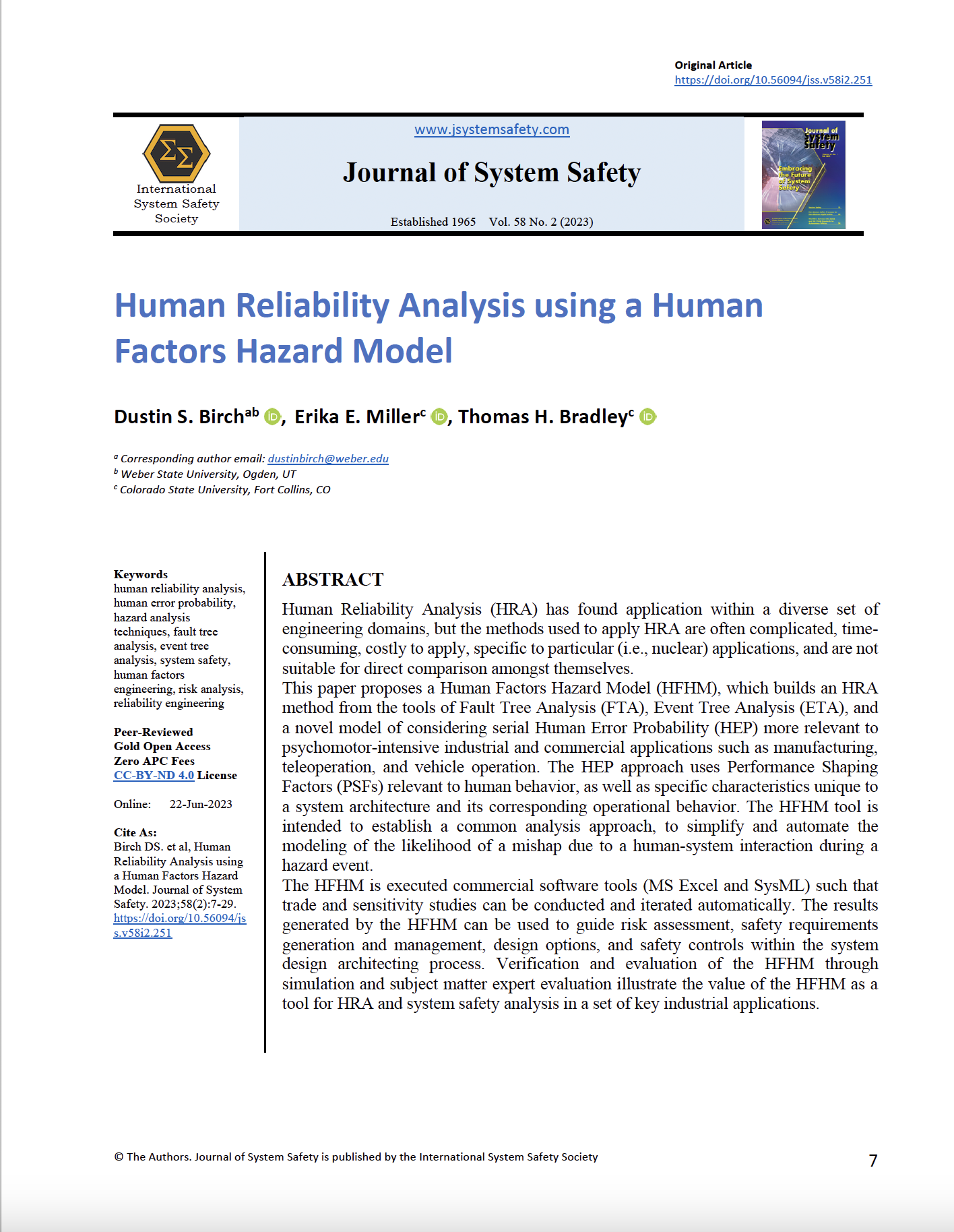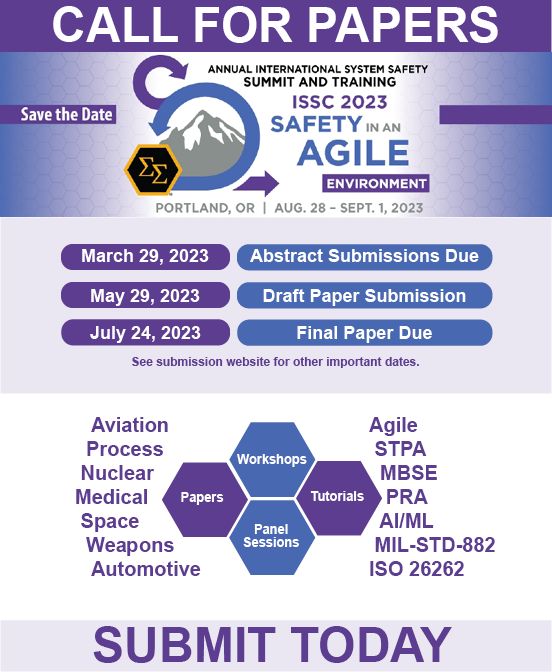Human Reliability Analysis using a Human Factors Hazard Model
DOI:
https://doi.org/10.56094/jss.v58i2.251Keywords:
human reliability analysis, human error probability, hazard analysis techniques, fault tree analysis, event tree analysis, system safety, human factors engineering, risk analysis, reliability engineeringAbstract
Human Reliability Analysis (HRA) has found application within a diverse set of engineering domains, but the methods used to apply HRA are often complicated, time-consuming, costly to apply, specific to particular (i.e., nuclear) applications, and are not suitable for direct comparison amongst themselves.
This paper proposes a Human Factors Hazard Model (HFHM), which builds an HRA method from the tools of Fault Tree Analysis (FTA), Event Tree Analysis (ETA), and a novel model of considering serial Human Error Probability (HEP) more relevant to psychomotor-intensive industrial and commercial applications such as manufacturing, teleoperation, and vehicle operation. The HEP approach uses Performance Shaping Factors (PSFs) relevant to human behavior, as well as specific characteristics unique to a system architecture and its corresponding operational behavior. The HFHM tool is intended to establish a common analysis approach, to simplify and automate the modeling of the likelihood of a mishap due to a human-system interaction during a hazard event.
The HFHM is executed commercial software tools (MS Excel and SysML) such that trade and sensitivity studies can be conducted and iterated automatically. The results generated by the HFHM can be used to guide risk assessment, safety requirements generation and management, design options, and safety controls within the system design architecting process. Verification and evaluation of the HFHM through simulation and subject matter expert evaluation illustrate the value of the HFHM as a tool for HRA and system safety analysis in a set of key industrial applications.
References
D.S. Birch, T.H. Bradley, Development of a Human Factors Hazard Model Using HEP / FTA / ETA, Wasatch Aerospace & Systems Engineering Conference (AIAA-INCOSE), 2021
N. Siu, Dynamic Accident Sequence Analysis in PRA: A Comment on 'Human Reliability Analysis - Where Shoudst Thou Turn?', Reliability Engineering & System Safety, Volume 29, Issue 3, 1990
https://doi.org/10.1016/0951-8320(90)90019-J
G. W. Hannaman, D.H. Worledge, Some Developments in Human Reliability Analysis - Approaches and Tools, Reliability Engineering & System Safety, Volume 22, Issus 1-4, 1988
https://doi.org/10.1016/0951-8320(88)90076-2
A. Spurgin, Another View of the State of Human Reliability Analysis (HRA), Reliability Engineering & System Safety, Volume 29, Issue 3, 1990
https://doi.org/10.1016/0951-8320(90)90020-N
N.A.A. Aziz, A. Fumoto, K. Suzuki, Assessing Human Error During Collecting a Hydrocarbon Sample of the Chemical Plant Using THERP, Journal of Fundamental and Applied Sciences, ISSN: 1112-9867, 2017
C.L. Ericson II, Hazard Analysis Techniques for System Safety, 2nd Edition, Wiley, 2016
D.I. Gertman, H.S. Blackman, Human Reliability and Safety Analysis Data Handbook, 3rd Edition, Wiley-Interscience, 1993
A.D. Swain, H.E. Guttmann, Handbook of Human Reliability Analysis with Emphasis on Nuclear Power Plant Applications, NUREG/CR-1278, SAND80-0200, 1983
https://doi.org/10.2172/5752058
M.K. Comer, D.A. Seaver, W.G. Stillwell, C.D. Gaddy, "Generating Human Reliability Estimates Using Expert Judgment", NUREG/CR-3688 - SAND84-7115, VOL 1 & 2, 1984
https://doi.org/10.2172/6180932
K.R. Boff, J.E. Lincoln, "Engineering Data Compendium: Human Perception and Performance", Harry G. Armstrong Aerospace Medical Research Laboratory, Wright-Patterson Air Force Base, 1988
B.S. Dhillon, Human Reliability with Human Factors, Pergamon Press, 1986
https://doi.org/10.1016/B978-0-08-032774-7.50018-0
S.J. Guastello, Human Factors Engineering and Ergonomics, 2nd Edition, CRC Press, 1986
M.V. Stringfellow, Accident Analysis and Hazard Analysis for Human and Organizational Factors, PhD Dissertation, Massachusetts Institute of Technology, 2010
R.B. Shirley, C. Smidts, M.Li, A. Gupta, Validating THERP: Assessing the Scope of a Full-Scale Validation of the Technique for Human Error Rate Prediction, Annals of Nuclear Energy, Vol. 77, Ohio State University, 2014
https://doi.org/10.1016/j.anucene.2014.10.017
D.E. Embrey, P. Humphreys, E.A. Rosa, B. Kirwan, K. Rea, SLIM-MAUD: An Approach to Assessing Human Error Probabilities Using Structured Expert Judgment, United States Nuclear Regulatory Commission - Human Factors and Safeguards Branch, Office of Nuclear Regulatory Research, Contract No. DE-AC02-76CH00016 Fin. No. A-3219, 1984
Pilot's Handbook of Aeronautical Knowledge, Federal Aviation Administration, U.S. Department of Transportation, FAA-H-8083-25B, 2006
Department of Defense Standard Practice - System Safety, MIL-STD-882E, Revision E, 2012
M. Stamatelos, J. Caraballo, W. Vesely, J. Dugan, J. Fragola, J. Minarick, J. Ralsback, Fault Tree Handbook with Aerospace Applications, NASA Office of Safety and Mission Assurance, V 1.1, 2002
G. Biggs, K. Post, A. Armonas, N. Yakymets, T. Juknevicius, A. Berres, OMG Standard for Integrating Safety and Reliability Analysis into MBSE: Concepts and Applications, INCOSE International Symposium, Volume 29, Issue 1, 2019
https://doi.org/10.1002/j.2334-5837.2019.00595.x
E. Schlosser, Command and Control: Nuclear Weapons, the Damascus Accident, and the Illusion of Safety, Penguin Books, 2013
Critical Reasons for Crashes Investigated in the National Motor Vehicle Crash Causation Survey, National Highway Traffic Safety Administration, U.S. Department of Transportation, DOT HS 812 115, 2015
M. Rauterberg, Perception, Cognition, Action: an Action Theoretical Approach, Systematica, Volume 14, Number 1, 1999
D.W. Carruth, M.D. Thomas, B. Robbins, A. Morais, Integrating Perception, Cognition, and Action for Digital Human Modeling, Digital Human Modeling, Lecture Notes in Computer Science, Volume 4561, 2007
https://doi.org/10.1007/978-3-540-73321-8_39
G.J. Burkholder, K.A. Cox, L.M. Crawford, J.H. Hitchcock, Research Design and Methods - An Applied Guide for the Scholar-Practitioner, Sage Publications, 2020
A.M. Williams, K.A. Ericsson, "Introduction to the Theme Issue: Perception, Cognition, Action, and Skilled Performance", Journal of Motor Behavior, Vol. 39 No. 5, 2007
https://doi.org/10.3200/JMBR.39.5.338-340
S.M.L. Hendrickson, G.W. Parry, J.A. Forester, V.N. Dang, A.M. Whaley, S. Lewis, E. Lois, J. Xing, "Towards an Improved HRA Method", Sandia National Laboratory, SAND2012-1319C, 2012
N.J. Ekanem, A. Mosleh, S. Shen, "Phoenix - A Model-Based Human Reliability Analysis Methodology: Qualitative Analysis Procedure", Reliability Engineering and System Safety, Vol. 145, 2016
https://doi.org/10.1016/j.ress.2015.07.009
D. Gertman, H. Blackman, J. Marble, J. Byers, C. Smith, "The SPAR-H Human Reliability Analysis Method", U.S. Nuclear Regulatory Commission, NUREG/CR-6883, 2005
J.R. Anderson, D. Bothel, M.D. Byrne, S. Douglass, C. Lebiere, Y. Qin, "An Integrated Theory of the Mind", Psychological Review, Vol. 111 No. 4, 2004
https://doi.org/10.1037/0033-295X.111.4.1036
HFHM Project, https://doi.org/10.5281/zenodo.7352422

Downloads
Published
How to Cite
Issue
Section
Categories
License
Copyright (c) 2023 Dustin S. Birch, Erika E. Miller, Thomas H. Bradley

This work is licensed under a Creative Commons Attribution-NoDerivatives 4.0 International License.













